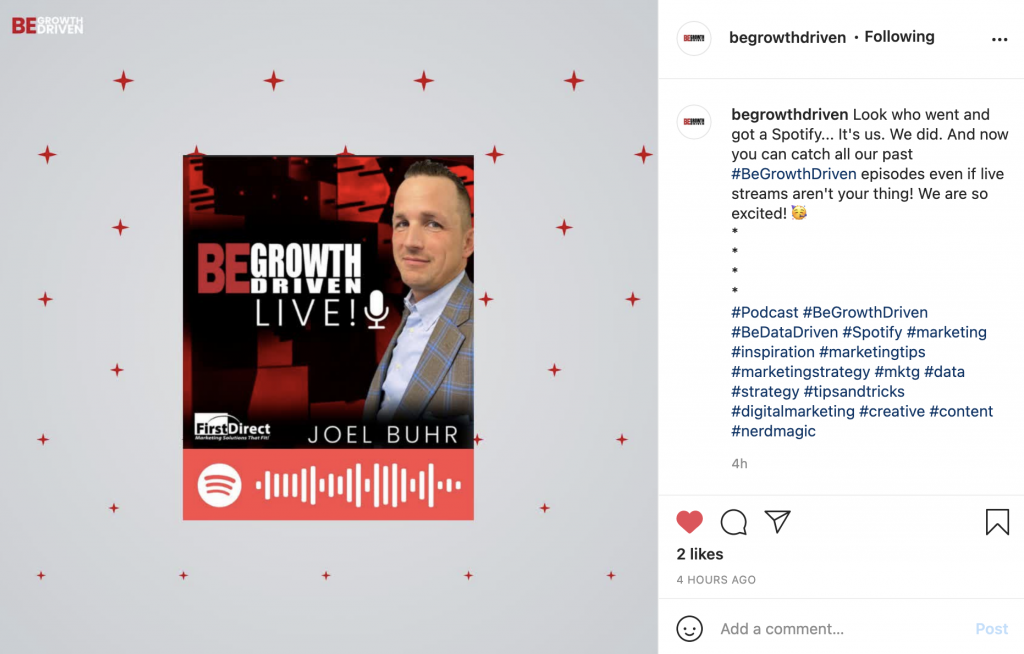What Do You Need to Create a Successful Podcast?
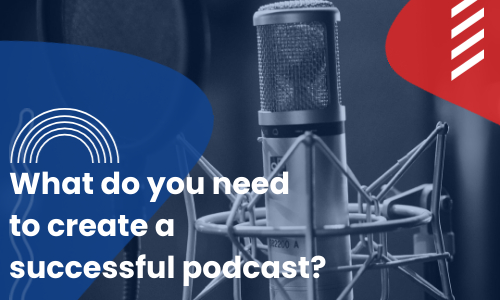
Nearly 51% of adult Americans listen to podcasts!
Here’s the steps you need to create your own successful podcast!
Step One: Get Over Your Fear!
The first step to success is to just start! There’s a lot of fears people have about starting a podcast.
“My voice sounds weird.”
“I don’t have enough technical know-how.”
“The equipment is expensive.”
“A podcast is time consuming.”
Chances are that once you get started, those fears will dissipate!
Step Two: What Do Want To Say?
One of the most important things about starting a new venture, like podcasting, is to have a mission. For example, our podcast, BeGrowthDriven, was started because our mission as a company is to help business grow. We wanted to connect like-minded business and entrepreneurs to share advice and recourses. That goal informs all the decisions we make about the podcast.
How to you want to help your audience or customers? What is the goal of your business? You can expand on that to create your podcast’s mission.
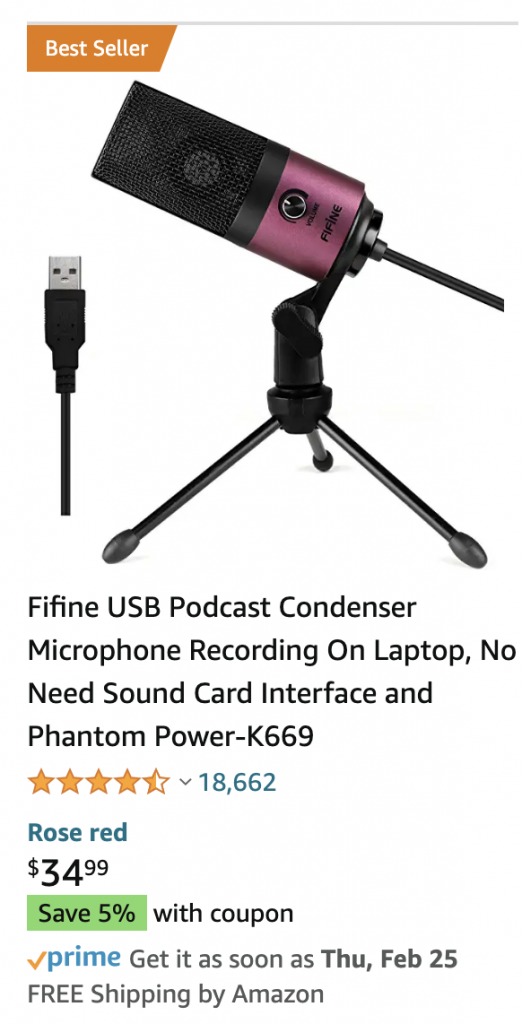
Step Three: Record Your First Episode
You don’t need expensive equipment to get started! (Though podcast mics start at like, $30 on Amazon.) Here’s what tools we have found to be helpful.
Part of recording your episode is the editing and mixing side of things. It’s totally up to you how much editing you want to do! It all depends on what you want the feel of your podcast to be.
Step Four: Publish Your Podcast
There are many directories to publish podcasts on. That big three are iTunes, Spotify, and Google Podcasts.
Doing well on iTunes/Apple Music is the goal. Around 70% of all podcast listens and downloads happen through Apple. It can be trickery to get monetarization on Apple than on Spotify or Google. So, having your podcast available on as many platforms as possible is good idea!
It’s also a good idea to publish three to five episodes at launch to give your new listeners something to listen to.
Step Five: Promote, Promote, Promote
Podcasting has been around for a long time so there are many recourses and tools available for promoting (or learning how to promote) your podcast. Here’s some tips and tricks
- Tap into your guest’s audience
Chances are if they are a good fit to be a guest on your podcast, there audience could also benefit form your content. Make it easy for your guest to share out pull quotes, images, and links from their episode.
- Use social media.
This is kinda a no brainer. Podcasts can be slip into so many different types of content that is easy to post them across many different platforms. Pull quotes do great on Instagram, Facebook, and LinkedIn. Links can be shared on twitter and Facebook. Twitter also has a great SoundCloud integration you can use.
Social media can be used to promote the episode ahead of time as well as sharing past highlights. Social media also is great way to connect with fans and listeners one personal level and add another channel for them to interact with you.
Step Six: Repurpose Content
Podcast content can be repurposed into many other different types of content. We’ve already talked about pull quotes and highlight clips, there’s way more things you can do. For one thing, it’s common place to film the recording of the podcast. That video can be put on YouTube. And video highlights can be put on social media. Putting the video on YouTube also gives you some accessibility features such as closed captioning. Since YouTube is owned by Google, videos on YouTube boost your overall brand SEO which as far-reaching benefits.
Another helpful way to repurpose podcast content is to have the podcast transcribed. If you don’t have time to do that yourself, (understandable: it’s time consuming) companies like Rev.com or Fiverr offer cheap transcription services. Once your podcast is transcribed, it can be used as blog content to make it accessible on another channel and boost SEO.
Step Seven: Get Featured On Other Podcasts!
A great way to promote your podcasts and reach new audiences is to be a guest on other podcasts! The podcast community is well connected and worth tapping into.
Do you have a podcast? We want to hear all about it!
The Best Social Media Platform For You
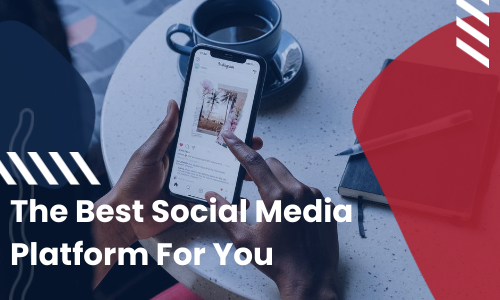
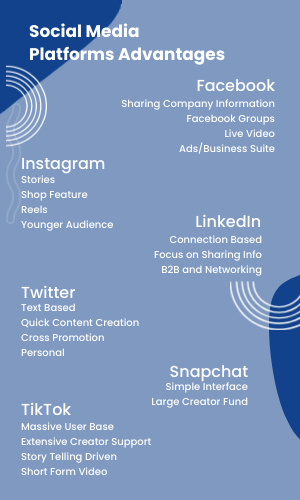
There are so. many. social media platforms available. Each have their own flavor and specialty. It can be overwhelming to figure what platforms are the best fit for you and your company.
Ideally, the answer to what platform should you use is: all of them! There are many tools and social schedulers available to make it easier to post to many accounts and platforms at once. However, even if you are able to consistently post to a wide variety of platforms, it is helpful to understand what each platform excels at. And, what each platform needs.
Let’s break it down:
Facebook has roughly 2.8 billion monthly users, and because of that, Facebook is in a lot of ways a necessary evil. Since Facebook owns some of the other platforms, having a Facebook business account is a necessity. From a content standpoint, Facebook really excels at four things.

- Sharing company information. Facebook (and Google my Business) are often the first place updated about hour changes, services, locations, etc.
- Facebook groups. Facebooks groups are an excellent way to build micro communities online. For example, we are a part of Facebook groups for specific SaaS products we use, different communities like the 10X community, as well as groups to network with like minded businesses. Because these groups are often moderated, they can provide a safe place.
- Live video. Facebooks live video and event scheduling feature is one of the most robust available. Because of Facebooks integrations with Instagram, it’s easy to stream to two places at once. Facebook catalogs video internally, meaning that Facebook video doesn’t help general search engine SEO, which is something to keep in mind.
- Ads. Facebook has its own ad platform that only works with their family of applications.
Instagram constantly adds features, so even though it started out as a purely visual platform, its effective for all businesses. Here’s some things to keep in mind about Instagram:
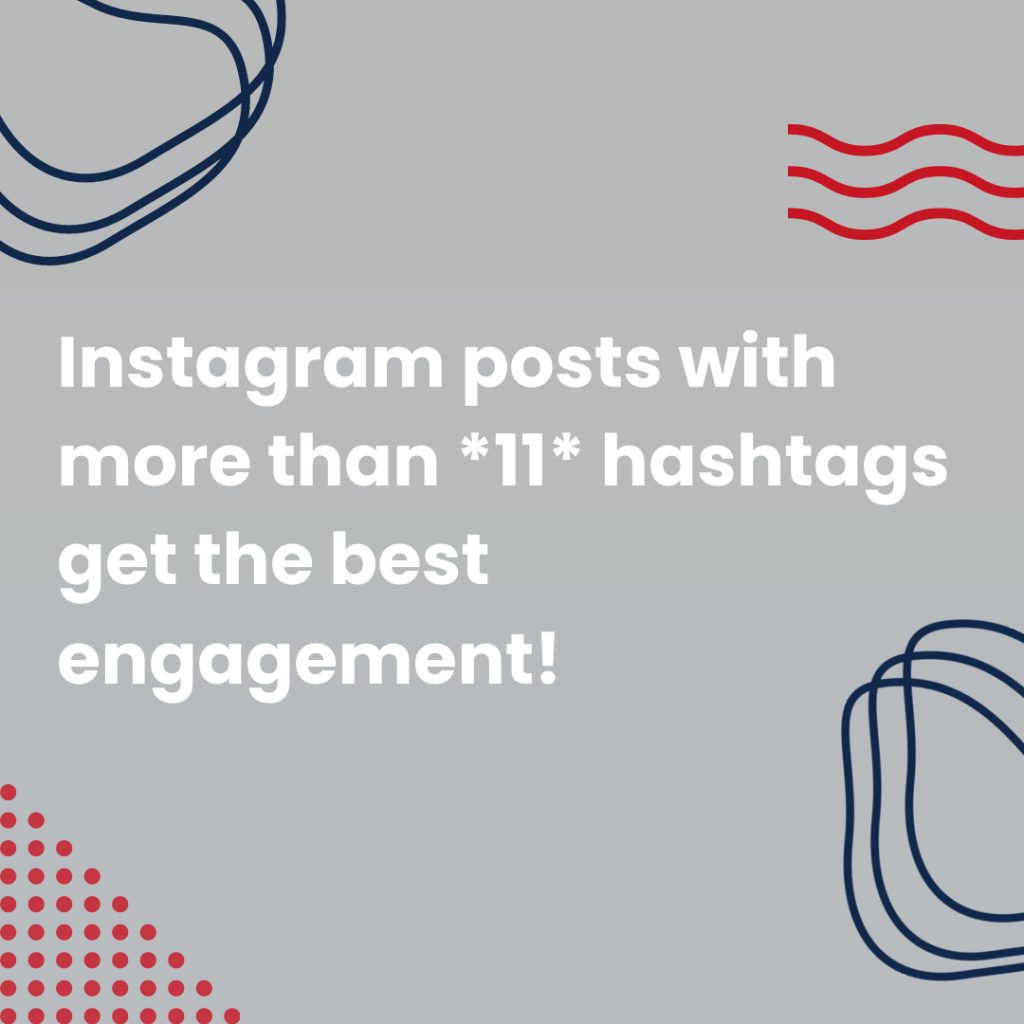
- Instagram stories have high engagement rates. They are great for creating authentic interactions with your followers. And they can be shared directly over to Facebook stories.
- Instagram shop feature is very comprehensive and easy to use. If you are a business that sells physical products, having an Instagram shop set up is very beneficial.
- Instagram Reels take parts of TikTok and YouTube and combine them together. Unlike, TikTok they don’t have a 1-minute time limit so you can say a lot more. Live video scan be converted directly to Reels.
- Instagram’s user base is generally younger than Facebook. More than 50% of Instagram users are between 18-35, while more than 60% of Facebook’s user are over 35.
LinkedIn has started to shift away from a purely networking platform to an information sharing platform as well. They recently added a live video feature and seem to be working to towards taking some of Facebook’s power away as the B2B social.
LinkedIn posts that are not self-promotion work well. It’s a great place to pull over blog information and transcriptions/scripts from live videos.
LinkedIn is all about connections, and interactions that are mutually beneficial. If you can find the right audience or community, chances are you will get a lot of engagement and connections.
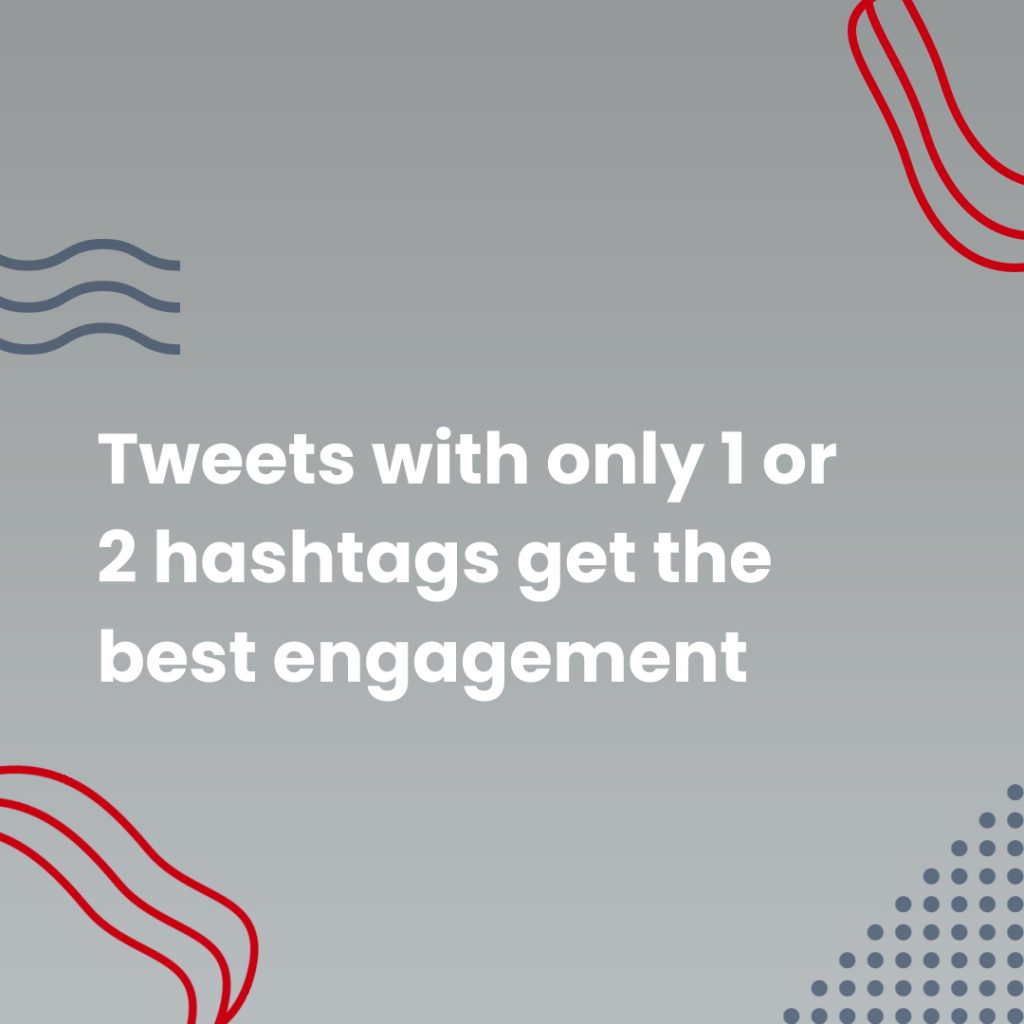
Twitter is easy to use and easy to generate content for. The snappy text-based format pushes engagement. Twitter is great for cross promotion across platforms. Screenshots of Tweets work well on other platforms. And Twitter is great for sharing links to your own content as well as highlighting other things you care about.
Twitter is also great for building personal relationships with followers. The stream of consciousness format can feel like a personal one-on-one conversation.
Snapchat
You may be surprised that Snapchat is included on this list. Snapchat’s audience skews very young which often eliminates it from company’s marketing plans. The platforms interface also makes it difficult to brand yourself and to find new followers. (Unlike most other platforms, Snapchat’s “explore” page doesn’t usually promote accounts to follow.)
However, Snapchat recently launched a creator fund. They have made extremely easy to get money as a creator on the platform. They seem to have learned from past mistakes and are pushing creators to use the app. (Many people reported making 6 figures in their first month!)
TikTok
TikTok is not just for the kids. It has a massive user pool, extensive creator funding, and a simple structure. It’s relatively simple to leverage their algorithms to your advantage. And since it’s a few years old at this point, there are established content formats and trends you can use.
It’s short form (60 seconds max) video format is great for storytelling and building personal relationships.
Many companies use it as an almost “behind the scenes” look at their day-to-day work. That type of content is great for engagement and creating brand loyalty.
TikTok is highlighting your personality or company culture.
What social media platforms do you view as essential?
Want help with getting your social media marketing rolling? Let us know!

